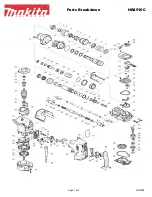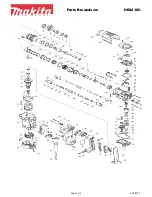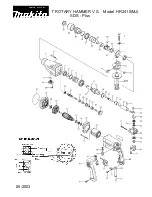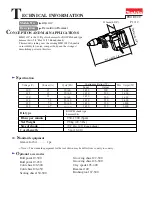
15
O R I G I N A L I N S T R U C T I O N S
EN
Drilling without impact should be used for wood, metals and some ceramics. For drilling with drill bits without SDS PLUS attach-
ment, use a self-centering drill chuck (sold separately) with an SDS PLUS spindle. It is recommended to use a key drill chuck.
Caution! If the drilling mode switch is set to the no-impact drilling, the position of the impact selector is irrelevant.
Rotational speed control (VII)
The hammer drill is equipped with a smooth adjustment of the rotation, which is done by turning the knob. The bigger the number
visible on the knob, the higher the rotational speed. A change in rotational speed entails a change in the frequency of the impact
and the energy of a single impact. Smooth adjustment is possible within the range speci
fi
ed in the technical data table.
A higher rotational speed should be set for drilling in metals and when drilling with small diameter drill bits. A lower rotational speed
is intended for drilling in ceramic materials and with larger diameter drills.
Preparing to work
Set the tool to the correct operating mode: drilling or hammer drilling or chiselling.
Select the right tool and install it in the chuck.
Wear hearing protectors, eye protection, work gloves.
Insert the plug of the power cord into mains socket.
Stand in a well-balanced position, grab the rotary hammer with both hands and start it by pressing the electrical switch (VIII) with
your
fi
nger.
Keep the tool working for a few minutes, until the lubricant has reached all components of the drive mechanism.
Switch the rotary hammer o
ff
by releasing the switch.
Caution!
When hearing any suspicious grinding or cracking sounds, immediately disconnect the rotary hammer from the mains
and have it check by an authorised service centre.
USING THE TOOL
Caution! Use hearing protectors during use of the hammer drill!
Drilling in wood
Before making a hole, it is recommended to
fi
x the workpiece with G clamps or in a vice, and then use a punch or a nail to mark
the drilling point. Install a correct drill bit in the chuck, set the speed, connect the drill to the mains and start drilling. When making
through holes, it is recommended to place a wooden pad under the material, so that the edge of the hole at the outlet will not be
torn. In the case of drilling holes with large diameters, it is recommended to drill a smaller guide hole beforehand.
Drilling in metals
Always fasten the workpiece securely. For a thin sheet, it is recommended to place a piece of wood under it to avoid unwanted
bends, etc. Then mark the locations of holes with a punch and start drilling. Use drill bits intended for steel. It is recommended
to use sintered carbide drill bits when drilling in white cast iron. When drilling larger holes, it is recommended to make a smaller
guide hole beforehand. When drilling in steel, use general purpose lubricating oil to cool the drill bit. For aluminium, use turpentine
or para
ffi
n as a coolant. Do not use cooling agents when drilling in brass, copper or cast iron. For cooling, remove the drill bit from
the material frequently to allow it to cool down.
Drilling in ceramics
Drilling in hard, compact materials: concrete, hard brick, stone, marble, etc.
With the hammer drill disconnected from the mains, install the drill bit in the chuck.
Install the drill depth stop if required.
Select impact drilling with the operating mode switch or, if available, non-impact drilling.
Insert the plug into the mains socket, switch on the hammer drill with a switch and start work.
Take regular breaks during work. Never allow the hammer drill and tool to overheat.
Hammer drilling is recommended only for compact ceramic materials such as concrete, hard brick, stone, etc. When drilling holes
with large diameters, it is recommended to make a pilot hole with a smaller diameter and then use a drill bit with the required size.
Drill bits designed for impact drilling should be used.
It is not recommended to use impact drilling for loose ceramic materials such as glazed tiles, soft brick, plaster, etc. This may
crack the material.
The hammer drill is equipped with a clutch to prevent overloading of the electric motor in the event that the installed tool gets stuck
during work. For example, if a rebar is hit. In this case, the drill will stop rotating even though the electric motor will continue to run.
Exerting too much pressure during operation may also activate the clutch.
If this happens, withdraw the tool inserted from the hole, check whether the hammer drill is working properly, and then resume
work applying only the pressure necessary for proper operation. If a rebar or other hidden metal objects are found, they should be
drilled through without the impact mode with a bit designed for drilling in metal of the same diameter as the impact drill, and then
drilling in ceramic material should continue.
















































